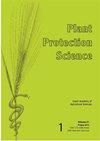Breeding Wheat for Rust Resistance: Conventional and Modern Approaches
IF 1.7
4区 农林科学
Q2 AGRONOMY
引用次数: 1
Abstract
Three rusts are destructive, diminishing produce and nutritious value significantly, affect food availability and consequently food security through reductions in yield. In agricultural research institutes with mandate of wheat improvement, incorporating genes resistant against rust is matter of routine. The dilemma of rusts in wheat has been addressed the most, leading to discovery of principles of plant breeding for resistance e.g. gene disease genes inherit following Mendelian genetics, concept of genetic diversity and concept of gene for gene theory. Two strategies of breeding wheat for disease resistance are being followed. 1- Conventional and 2- Advanced. Among conventional approaches selection and hybridization are well known. However rust resistance has been found short lived and may also be durable in certain cases. Durability of disease resistance is desired and has been explored widely. Durability of resistance is generally attained through incorporation of genes effective at adult plant stage and combination of quantitative genes. Application of biotechnology to improve productivity of rust resistance breeding is the usage of molecular markers in pyramiding genes and substantiates the existence of genes in, and confirming released cultivars are pure. This involves molecular markers that are precise and pertinent across extensive ranges of breeders’ germplasm. This review article encompasses all features of wheat development through application of different techniques of wheat improvement. However, despite development of novel approaches that has accelerated wheat breeding, breeding in pathogen leading to producing more virulent strains. Consequently, wheat breeding is a continuous process.小麦抗锈病育种:传统与现代方法
三种锈病具有破坏性,显著降低了农产品和营养价值,通过减产影响粮食供应,从而影响粮食安全。在具有小麦改良任务的农业研究机构中,引入抗锈病基因是一件常规的事情。小麦锈病的困境得到了最广泛的解决,从而发现了孟德尔遗传的基因疾病遗传原理、遗传多样性概念和基因对基因理论的概念等植物抗性育种原理。目前正在采用两种小麦抗病育种策略。1-常规,2-先进。在传统的方法中,选择和杂交是众所周知的。然而,在某些情况下,抗锈性是短暂的,也可能是持久的。抗病性的持久性是人们所期望的,并得到了广泛的探索。抗性的持久性一般是通过加入在成虫期有效的基因和数量基因的组合来实现的。利用生物技术提高抗锈病育种生产力是利用分子标记对基因进行金字塔化,证实基因的存在,并确认释放品种的纯度。这涉及到分子标记,这些分子标记在育种者的种质资源的广泛范围内是精确和相关的。本文通过应用不同的小麦改良技术,综述了小麦发育的所有特征。然而,尽管新方法的发展加速了小麦育种,但病原菌的育种导致产生毒性更强的菌株。因此,小麦育种是一个连续的过程。
本文章由计算机程序翻译,如有差异,请以英文原文为准。
求助全文
约1分钟内获得全文
求助全文
来源期刊

Plant protection science
Agronomy-PLANT SCIENCES
CiteScore
2.90
自引率
7.70%
发文量
30
审稿时长
12 weeks
期刊介绍:
Original papers, short communications, critical reviews, personal news, and book reviews covering all areas of diseases and pests of plants, weeds and plant protection. Papers are published in English.
 求助内容:
求助内容: 应助结果提醒方式:
应助结果提醒方式:


